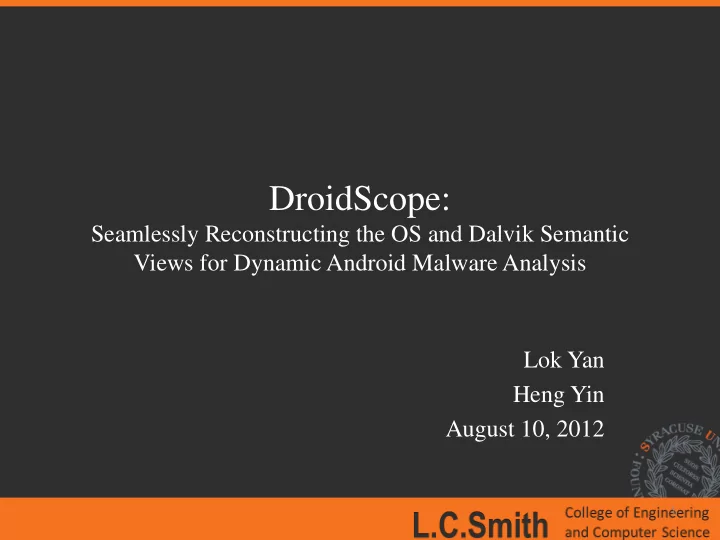

DroidScope: Seamlessly Reconstructing the OS and Dalvik Semantic Views for Dynamic Android Malware Analysis Lok Yan Heng Yin August 10, 2012 1
Android Java Components System Services Native Components Apps 2
Android Java Components Native Components System Services Apps 3
Motivation: Static Analysis Dalvik/Java Static Analysis: ded, Dexpler, soot, Woodpecker, DroidMoss Native Static Analysis: IDA, binutils, BAP 4
Motivation: Dynamic Analysis Android Analysis: TaintDroid, DroidRanger System Calls logcat, adb 5
Motivation: Dynamic Analysis External Analysis: Anubis, Ether, TEMU, … 6
DroidScope Overview 7
Goals • Dynamic binary instrumentation for Android – Leverage Android Emulator in SDK – No changes to Android Virtual Devices – External instrumentation • Linux context • Dalvik context – Extensible: plugin-support / event-based interface – Performance • Partial JIT support • Instrumentation optimization 8
Roadmap External instrumentation – Linux context – Dalvik context • Extensible: plugin-support / event-based interface • Evaluation – Performance – Usage 9
Linux Context: Identify App(s) • Shadow task list – pid, tid, uid, gid, euid, egid, parent pid, pgd, comm – argv[0] • Shadow memory map – Address Space Layout Randomization (Ice Cream Sandwich) • Update on – fork, execve, clone, prctl and mmap2 10
Java/Dalvik View • Dalvik virtual machine – register machine (all on stack) – 256 opcodes – saved state, glue , pointed to by ARM R6, on stack in x86 • mterp – offset-addressing: fetch opcode then jump to (dvmAsmInstructionStart + opcode * 64) – dvmAsmSisterStart for emulation overflow • Which Dalvik opcode? 1. Locate dvmAsmInstructionStart in shadow memory map 2. Calculate opcode = (R15 - dvmAsmInstructionStart) / 64. 11
Just In Time (JIT) Compiler • Designed to boost performance • Triggered by counter - mterp is always the default • Trace based – Multiple basic blocks – Multiple exits or chaining cells – Complicates external introspection – Complicates instrumentation 12
Disabling JIT 13
Roadmap External instrumentation – Linux context – Dalvik context Extensible: plugin-support / event-based interface • Evaluation – Performance – Usage 14
Instrumentation Design • Event based interface – Execution: e.g. native and Dalvik instructions – Status: updated shadow task list • Query and Set, e.g. interpret and change cpu state • Performance – Example: Native instructions vs. Dalvik instructions – Instrumentation Optimization 15
Dynamic Instrumentation Update PC (un)registerCallback yes inCache? needFlush? no yes Translate flushType invalidateBlock(s) flushCache Execute 16
Instrumentation 17
Dalvik Instruction Tracer (Example) 1. void opcode_callback(uint32_t opcode) { 2. printf("[%x] %s\n", GET_RPC, opcodeToStr(opcode)); 3. } 4. 5. void module_callback(int pid) { 6. if (bInitialized || (getIBase(pid) == 0)) 7. return; 8. 9. gva_t startAddr = 0, endAddr = 0xFFFFFFFF; getModAddr(“dfk@classes.dex”, &startAddr, &endAddr); 10. 11. addDisableJITRange(pid, startAddr, endAddr); 12. disableJITInit(getGetCodeAddrAddress(pid)); 13. addMterpOpcodesRange(pid, startAddr, endAddr); 14. dalvikMterpInit(getIBase(pid)); 15. registerDalvikInsnBeginCb(&opcode_callback); 16. bInitialized = 1; 17. } 18. 19. void _init() { 20. setTargetByName("com.andhuhu.fengyinchuanshuo"); 21. registerTargetModulesUpdatedCb(&module_callback); 22. } 18
Plugins • API Tracer – System calls • open, close, read, write, includes parameters and return values – Native library calls – Java API calls • Java Strings converted to C Strings • Native and Dalvik Instruction Tracers • Taint Tracker – Taints ARM instructions – One bit per byte – Data movement & Arithmetic instructions including barrel shifter – Does not support control flow tainting 19
Roadmap External instrumentation – Linux context – Dalvik context Extensible: plugin-support / event-based interface Evaluation – Performance – Usage 20
Implementation • Configuration – QEMU 0.10.50 – part of Gingerbread SDK – Gingerbread • “user-eng” • No changes to source – Linux 2.6.29, QEMU kernel branch 21
Performance Evaluation • Seven free benchmark Apps – AnTuTu Benchmark – (ABenchMark) by AnTuTu – CaffeineMark by Ravi Reddy – CF-Bench by Chainfire – Mobile processor benchmark (Multicore) by Andrei Karpushonak – Benchmark by Softweg – Linpack by GreeneComputing • Six tests repeated five times each – Baseline – NO-JIT Baseline – uses a build with JIT disabled at runtime – Context Only – API Tracer – Dalvik Instruction Trace 22 – Taint Tracker
Select Performance Results APITracer vs. NOJIT Results are not perfect Dynamic Symbol Retrieval Overhead 23
Usage Evaluation • Use DroidScope to analyze real world malware – API Tracer – Dalvik Instruction Tracer + dexdump – Taint Tracker – taint IMEI/IMSI @ move_result_object after getIMEI/getIMSI • Analyze included exploits – Removed patches in Gingerbread – Intercept system calls – Native instruction tracer 24
Droid Kung Fu • Three encrypted payloads – ratc (Rage Against The Cage) – killall (ratc wrapper) – gjsvro (udev exploit) • Three execution methods – piped commands to a shell (default execution path) – Runtime.exec() Java API (instrumented path) – JNI to native library terminal emulator (instrumented path) – Instrumented return values for isVersion221 and getPermission methods 25
Droid Kung Fu: TaintTracker 26
DroidDream • Same payloads as DroidKungFu • Two processes – Normal droiddream process clears logcat – droiddream:remote is malicious • xor-encrypts private information before leaking • Instrumented sys_connect and sys_write 27
Droid Dream: TaintTracker 28
DroidDream: crypt trace 29
Summary • DroidScope – Dynamic binary instrumentation for Android – Built on Android Emulator in SDK – External Introspection & Instrumentation support – Four plugins • API Tracer • Native Instruction Tracer • Dalvik Instruction Tracers • TaintTracker – Partial JIT support 30
Related Works • Static Analysis – ded, Dexpler, soot – Woodpecker, DroidMoss • Dynamic Analysis – TaintDroid – DroidRanger – PIN, Valgrind, DynamoRIO – Anubis, TEMU, Ether, PinOS • Introspection – Virtuoso – VMWatcher 31
Challenges • JIT – Full JIT support – Flushing JIT cache • Emulation detection – Real Sensors: GPS, Microphone, etc. – Bouncer • Timing assumptions, timeouts, events • Closed source systems, e.g. iOS 32
Questions? Q0. Where can I get DroidScope? 33
Recommend
More recommend